A commercial airliner today would take about 50 hours to complete a turn around the maximum circumference of the Earth, the Equator, a distance of 40,000 kilometers. Five hundred years ago, however, little was known about the real size of our planet. The ancient Greeks were aware that the Earth is a sphere, and had even estimated how large it was; and Christopher Columbus had already set foot in Central America. However, the immensity of the Pacific Ocean was still outside the realm of knowledge, and the southern tip of South America had not even been sighted yet.
The Treaty of Tordesillas of 1494 had divided the globe into two zones for maritime exploration and trade. The Western zone, which embraced almost the entirety of the Americas, was set aside for Spain, while the eastern zone – including the western coast of Africa and the route to the Indian Ocean and Asia – was reserved for the Portuguese.
So, since Spain was barred from reaching Asia by means of the hitherto known route around the African continent, it now sought to find an alternative route to the Spice Islands—known today as the Moluccas.
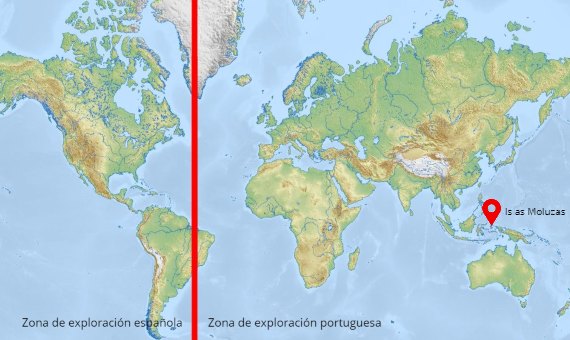
That was when Fernão de Magalhães (Ferdinand Magellan), a Portuguese seaman who had spent eight years in the Portuguese Navy in the Indian Ocean and knew the area well, proposed an expedition to find a westward sea route to Asia. After being rebuffed by the King of Portugal, who already had his own exclusive African route, Magellan was granted a command by King Charles I of Spain—also known as the Holy Roman Emperor Charles V. The mission would turn out to be pioneering in the exploration of the globe.
Magellan’s goal was purely a commercial one: by opening up a new trade route, he would give Spain its own way to the Spice Islands and hence access to some of the most prized goods of the age.
A “suicide mission”
On August 10, 1519, five ships sailed from Seville with 241 men on board, combining at least nine different nationalities. From the outset, the crews of the different ships got on poorly together. That the head of the expedition should be Portuguese riled the Spanish captains under his command, who suspected their leader might betray the Spanish Crown (which, in the event, he never did).
To make things worse, many of the crew had scant confidence in the leadership’s decisions, because this was a journey that would lead them to sail uncharted waters and discover mysterious lands on which no European had ever set foot. Yet another reason for the seamen’s skepticism about the chances of success were the dire conditions of health and safety and the lack of any charts or maps for anywhere beyond northern Brazil.
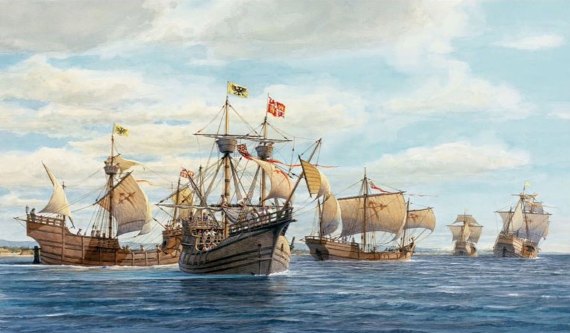
Four months after their departure from Spain, the ships reached the Americas, and then hugged the coast southward, seeking any possible way through to the Pacific. When they finally arrived at the southern tip of the continent, it was March 1520, when the cold season in the southern hemisphere starts to set in. Provisions were now scarce, the days were ever shorter, and the cold was rapidly closing in. They decided to sit out the winter in the Bay of San Julián, where they spent seven months before resuming their travels. During that time, internal strife became even worse, even to the point of mutiny. Magellan managed to quell his enemies, however. As a further misfortune, one of the vessels, which had been sent out surveying, ran aground and was wrecked on the coast.
The yearned-for passage to the Pacific
It was on October 21, 1520 when the expedition approached what we know today as the Strait of Magellan, a maze-like archipelago that is so complicated to navigate that the explorers’ hopes could well have been dashed here. One of the ships deserted and headed back to Spain; the crew had lost all confidence in the mission and disliked Magellan’s perceived excess of authority. Crossing the 530 kilometers of the strait is a severe challenge, but 38 days later, the three remaining ships reached the Pacific and set a course for Asia.
They had no charts to navigate by and little idea of the size of the globe, and so their progress was practically blind. Their estimates in fact underestimated the immensity of the Pacific and misled Magellan to believe they would take far less than they did. This proved the toughest stretch of the journey. Lack of food made scurvy rife, and the crew became so famished they ate the leather cladding on the mast, and rat’s flesh became a delicacy. The water was spoiled by the moisture from the wood in the barrels. And so they spent three months before landing on Guam, and then the Philippines.
An unforeseen death
In the Philippines, there was an unexpected shock that would change the course of events: Magellan, who had held his command with an iron grip and was certain of a successful mission and return to Spain, led his men—overconfidently, perhaps—against an army of hostile natives on the island of Mactan, and was killed in the ensuing skirmish.
After Magellan’s death, a further thirty crew members were treacherously ambushed and murdered at a feast. The expedition then departed the Philippines bound for the main destination—the Moluccas, or “Spice Islands”—with only 116 men, fewer than half the original number. As they were now too few to crew all three ships, the remaining explorers decided to abandon the Concepción, which they burned on the shore. They continued their way to the Moluccas with the Trinidad and the Victoria.
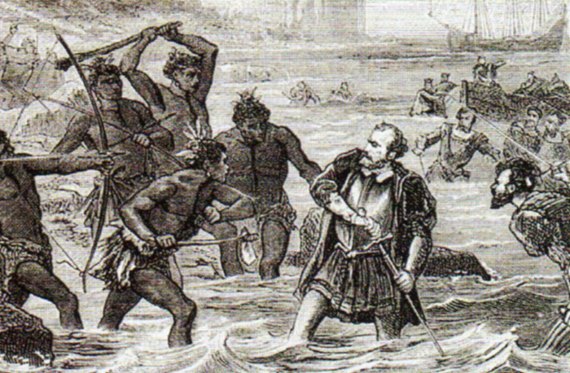
Overall command of the mission then fell to Gonzalo Gómez de Espinosa, the captain of the Trinidad; the Victoria was under the captaincy of Juan Sebastián Elcano. After reaching the Moluccas and filling the holds with precious spices, it was time to set a course back to Spain. Yet the Trinidad sprang a leak and was no longer seaworthy. Hence, the Victoria, under the command of Elcano, set sail on its own, destined to become the first ship to circumnavigate the globe.
An (also) troubled end of journey
With a crew of 60 men, the Victoria’s mission was a hazardous one, as they had to return to Spain by the route monopolized by Portugal and ran the risk of being boarded and arrested by the Portuguese. The explorers first decided to complete the journey in a single leg, not putting into any port on the way. Though a necessary decision, it put the expedition at risk, as conditions on board ship became extreme. Supplies were scarce and famine and scurvy cost the lives of many of the crew.
At the risk of being unable to complete their mission, the seamen then decided to alight in Cape Verde, a Portuguese possession, and replenish supplies. To avoid arrest, they had to deceive the Portuguese with the claim they had come from the Americas. The island authorities saw through the ruse, however, and arrested 13 men. Those remaining on the Victoria fled Cape Verde and headed for Spain, where they arrived on September 6, 1522.
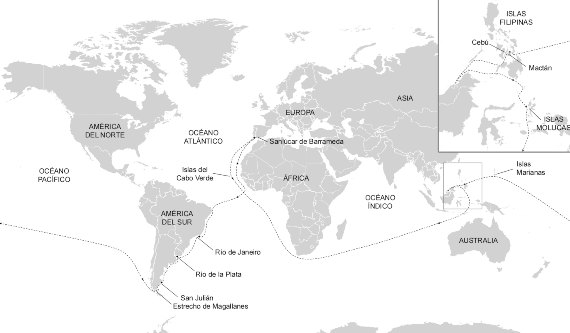
Of the 241 men who set sail, only 18 had made it: they were welcomed in Seville by the city authorities and a cheering crowd. Moreover, the Victoria was laden with 27 tons of cloves, an expensive spice, which sufficed to cover the costs of the expedition. Twelve other men came back from Cape Verde after being freed, and five further survivors from the Trinidad finally returned to Spain years later.
A historic landmark with a scientific legacy
The Magellan-Elcano expedition was not only the first to circumnavigate the globe but also pioneered many other historical and scientific advances. First, the expedition tangibly confirmed that the Earth was round—even though this had been taken for granted by that time, it was now also possible to complete contemporary maps of the Earth and corroborate the hitherto unsuspected immensity of the ocean that separated the Americas from Asia: Magellan named it the “Pacific.”
The explorers also named many of the lands first sighted on that journey, such as Montevideo, Tierra del Fuego or Patagonia, and animal species never before seen by Europeans were discovered, such as the penguin, the llama, the alpaca and the guanaco. Sailing across the Pacific, they were the first Europeans to set eyes on the two galaxies that would later be dubbed “the Magellanic Clouds.”
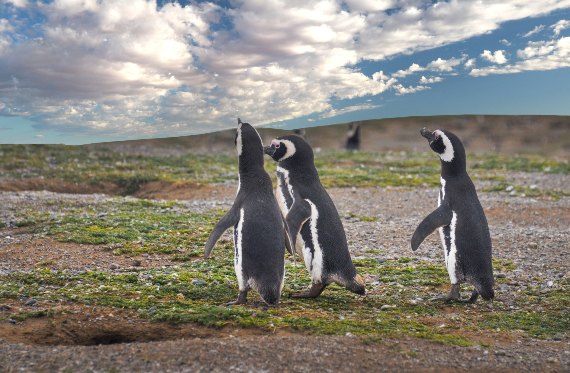
The expedition succeeded in opening up a new world trade route and laid the foundations for global commerce for the first time. The Strait of Magellan remained the westward route to Asia until 1914, when the Panama Canal was inaugurated.
In addition, the expedition raised an issue to which no one had previously given any thought. Upon arriving in Cape Verde, the Portuguese told the explorers the date was June 10 when, according to their own calculations, it was the 9th. They realized that, having circled the world in a direction contrary to the rotation of the Sun, they had lost a day. The matter was brought to the attention of the King of Spain and the Pope several centuries before the world was divided into modern time zones.
Comments on this publication